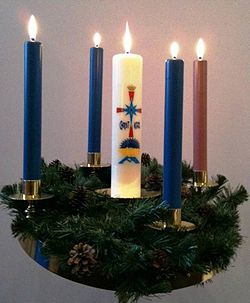Melody
Sei uns willkommen, Herre Christ appeared in the 1975 Gotteslob , a German Catholic hymnal, as GL 131 with a 14th or 15th century melody from Aachen in modern notation and with the addition of a new second verse from 1970. It is no longer included in the main section of the new Gotteslob , introduced on the first Sunday of Advent in 2013, but the regional section of the Diocese of Limburg includes it as GL 757. The current Protestant hymnal Evangelisches Gesangbuch (EG 22) includes it as a round under the title Nun sei uns willkommen, Herre Christ, with a 1934 canon melody by Walter Rein. [5]
Ancient melody

Source: [6]
Modern melody

Source: Gotteslob (1975) nr. 131
